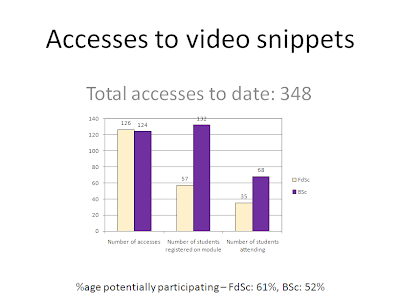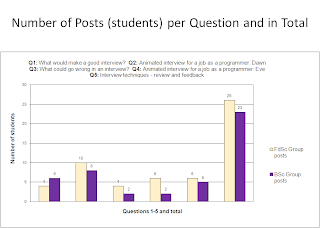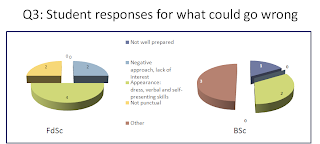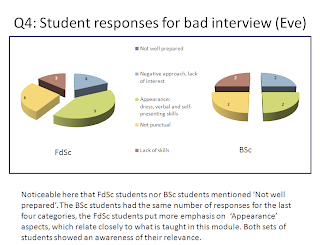Xtranormal avatars - Kay and Penny
Animated Videos for Interview Skills
Participative Design for Interview Skills:
Pilot Evaluation of Animated Video Snippets
Perception of need
Graduate employment can influence
Interview skills can affect employability
First year modules prepare students
Role-play can provide interview practice
- choice of university
- reputation and popularity of a course
Interview skills can affect employability
First year modules prepare students
- important for all students
- FdSc students undertake placements in second year
http://www.peo.gov.au/images/misc/diy_roleplay.gif
Role-play can provide interview practice
- students are reluctant to participate
- difficult to replicate for different groups
Videos would allow replication
- existing videos over-long
- not always appropriate
- not possible to make changes
http://www.fuzz2buzz.com/files/imagecache/node-view/Job%20Interview%20jpg%20V2.jpg
There is no second chance...
...to make a first impression
Instructional Models and Action Research
Overview of instructional models:
Bloom's taxonomy
Representation of the new terminology of Bloom's Taxonomy.
Change from Nouns to Verbs to describe the different levels of the taxonomy.
Top two levels are exchanged from the Old to the New version.
“All participants – including the researchers, the teachers, and the students – contribute to the process by which meaning is extracted from the data and in decisions about modifications that are made in the next cycle or iteration.
Proponents of action research often talk about involving all the major stakeholders in the evaluation process. In the simplest case this means both the instructors and their students.”
The cycles in the ADDIE model and the Action Research protocol mirror each other, and thus are mutually enabling.
The ADDIE model
Dick and Carey model mapping to other learning theories
Bloom's taxonomy
Representation of the new terminology of Bloom's Taxonomy.
Change from Nouns to Verbs to describe the different levels of the taxonomy.
Top two levels are exchanged from the Old to the New version.
Action Research model
“All participants – including the researchers, the teachers, and the students – contribute to the process by which meaning is extracted from the data and in decisions about modifications that are made in the next cycle or iteration.
Proponents of action research often talk about involving all the major stakeholders in the evaluation process. In the simplest case this means both the instructors and their students.”
Bodner G, MacIsaac D, White S (1999)
The cycles in the ADDIE model and the Action Research protocol mirror each other, and thus are mutually enabling.
Videos for interview skills
Classification and Analysis of existing material - YouTube videos
Identification of animation tools
Creation of Xtranormal videos
- Real people (more than one)
- Real people (only one)
- Animated characters
- Captions, keywords
- Feedback to interviewee
- Encourages reflection
- Feedback from viewer
- Time (minutes:seconds)
Identification of animation tools
- goanimate http://goanimate.com/
- livingactor http://www.livingactor.com/Presenter/
- xtranormal http://www.xtranormal.com/
Creation of Xtranormal videos
- choice of sets
- choice of avatars
- selection of voice
- storyboard
- conversation
- camera angles
- gestures
- recorded on mobile phone
- uploaded to YouTube
- embedded in blog http://pd-int-skills.blogspot.co.uk/
- preview edited in response to feedback
Stages of the study
Stage 1:
Initial feedback from colleagues
Initial feedback from colleagues
Stage 2:
Early feedback from sample of target audience
Stage 3:
Early feedback with final year students, with discussion
Stage 4:
Release of material for target audience (a) with blog responses
Stage 5:
Release of material for target audience (b) with blog responses
Stage 6:
Follow-up with final year students previously involved with feedback, with discussion
and later...
students asking for access after pilot stage of study completed
Data Analysis
An analysis of the responses submitted in comments
by students in the target audience
FdSc students concentrated on aspects that could be in control of the applicant
BSc students also mentioned other aspects, including possibility of:
- racism
- sexism
- other bias
of interviewers, and ‘overly ambiguous questioning’.
One student mentioned:
‘one may demonstrate a lot of experience, though in a few weeks time at the job proving that he does not have them’signalling over-estimation of skills, overconfidence at the point of interview, not realising the limitations of their knowledge and how much more there is left to know.
A little learning is a dangerous thing
Pope (1709)
Admitting one's ignorance is the beginning of wisdom
Socrates (469-399 BC)
Conclusions and Further Work
Video snippets are popular with students:
Animated videos could be used in a variety of contexts:
- not too short - not too long = just right
- on-demand access
- encourage reflective practice within blogs
Animated videos could be used in a variety of contexts:
- training interviewers
- supporting students with disabilities for presentations
- assessment - students constructing interviews
- explanations of topics (e.g. Gantt charts)
Participative Design of Animated Videos for Interview Skills - Tool
The software tool used to develop the animated videos used in this pilot study was Xtranormal, available at:
The tool is easy to use and can be demonstrated
Subscribe to:
Comments (Atom)


















